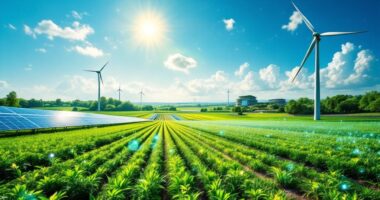Sustainable landscaping transforms ordinary yards into eco-friendly havens that work with nature, not against it. By incorporating native plants, water-saving techniques like drip irrigation, and permeable materials, homeowners create beautiful spaces that require less maintenance and support local wildlife. These environmentally conscious designs reduce water usage, minimize chemical interventions, and promote healthy soil ecosystems. Swapping traditional lawns for native meadows or groundcovers delivers stunning results while protecting our planet’s precious resources.

While traditional landscaping often prioritizes aesthetics over ecology, environmental landscaping offers an invigorating alternative that harmonizes beauty with planetary health. This approach transforms yards from mere decorative spaces into thriving ecosystems that benefit both homeowners and the natural world. Think of it as giving Mother Nature a stylish makeover that she actually approves of.
At the heart of sustainable landscaping lies the humble native plant—nature’s low-maintenance superstar. These botanical locals have evolved over millennia to thrive in your specific region without the helicopter parenting that exotic plants demand. Native plants sip water modestly, shrug off local pests, and roll out the welcome mat for birds, bees, and butterflies. It’s like hosting a neighborhood block party where everyone actually shows up!
Water conservation techniques form another vital element in the eco-friendly yard. Drip irrigation delivers moisture precisely where plants need it, cutting water usage by up to 90% compared to traditional sprinklers. Rain barrels capture nature’s free bounty, while strategic plant grouping—or “hydrozoning”—guarantees that thirsty plants aren’t making their drought-tolerant neighbors uncomfortable at the garden party. Implementing rainwater harvesting systems provides a sustainable source of irrigation while reducing dependence on municipal water supplies.
Sustainable materials contribute substantially to reducing landscape carbon footprints. Permeable pavers allow rainwater to percolate into the ground rather than rushing into storm drains. Recycled materials and locally sourced stones minimize transportation impacts, while solar lighting transforms sunshine into nighttime ambiance without the electricity bill. Creating permeable hardscapes offers the additional benefit of reducing erosion and contributing to groundwater replenishment.
Smart materials make gardens both beautiful and earth-friendly, turning your outdoor space into a climate hero in disguise.
Healthy soil serves as the foundation of any sustainable landscape. Composting transforms kitchen scraps and yard waste into black gold for plants. This natural fertilization cycle mimics forest floors, where decomposition feeds new growth in an endless loop of renewal.
Lawn alternatives offer particularly dramatic environmental benefits. Native meadows, groundcovers, and rain gardens require far less maintenance than traditional turf while providing superior wildlife habitat. These living carpets absorb carbon, filter pollutants, and create visual interest that static green lawns simply can’t match.
Through these integrated approaches, sustainable landscaping creates outdoor spaces that aren’t just pretty faces, but hard-working environmental allies in disguise.
Frequently Asked Questions
How Much Does Sustainable Landscaping Typically Cost?
Sustainable landscaping costs vary widely based on project scope. The national average for a professionally-designed yard runs about $30,000, with ranges from $15,000 to $150,000+.
Factors affecting price include project size, site conditions, desired features, and material selection. Basic design plans start at $300-$1,000, while advanced plans can reach $15,000.
Despite higher upfront costs, sustainable landscapes offer long-term savings through reduced water usage, lower maintenance requirements, and decreased energy costs.
Can Sustainable Landscaping Work in All Climate Zones?
Sustainable landscaping works effectively across all climate zones by adapting techniques to local conditions. The key lies in selecting native plants suited to regional rainfall patterns and temperatures.
Hot regions benefit from xeriscaping and shade placement, cold areas utilize windbreaks and hardy species, while temperate zones excel with rain gardens and permeable paving. Universal approaches like smart irrigation and organic maintenance transcend climate differences, ensuring sustainability principles can flourish anywhere with proper adaptation to local environmental factors.
How Much Water Does Sustainable Landscaping Save Annually?
Water savings from sustainable landscaping vary substantially by region and technique. Research shows reductions ranging from 35-75% compared to traditional landscaping.
Specific examples include Las Vegas saving 55.8 gallons annually per square foot of turf converted to xeriscape, and weather-based irrigation controllers saving about 9,000 gallons per year. Florida-Friendly Landscaping uses 50% less water than conventional landscapes, while xeriscaping in Albuquerque has demonstrated a 33% water reduction through rebate programs.
What Are the Best Native Plants for Small Urban Spaces?
Small urban spaces thrive with native plants like Butterfly Weed, which attracts monarchs with its vibrant orange blooms, and the cheerful yellow Black-Eyed Susan. Purple Coneflower delivers both beauty and medicinal benefits, while delicate Columbine attracts hummingbirds.
New England Aster provides late-season color when other plants fade. These natives require minimal maintenance, support local wildlife, and adapt beautifully to containers when space is truly at a premium.
How Long Until a Sustainable Landscape Becomes Fully Established?
A sustainable landscape typically reaches full establishment in 5-10 years, though this timeline varies. Native plants establish faster (1-3 years) than trees and shrubs (3-5 years).
The process unfolds in stages: first-year root development, accelerated growth in years 2-3, maturity by years 3-5, and ecosystem services emerging in years 5-7. Success indicators include developed root systems, reduced watering needs, increased biodiversity, improved soil composition, and resilience to environmental stressors.









